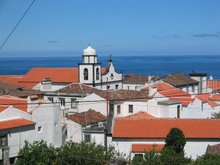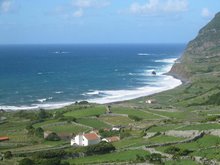I must say I had suspected that the numbering fairies had been hanging out round the wrong magic toadstools but the answer's really blindingly obvious. There are more houses stretching further out the village on the other side of the road than on our side. And as the numbering started from the outside working in, we're the third house on the left but Tiago and Liliana across the road from us are the fourteenth on the right ...
Except they're not. They're the twelfth. Further investigation (you can see I've got too much time on my hands) revealed that there's a gap between Nos. 22 and 28. This suggests to me that the numbering fairies believe that there are two houses - Nos. 24 &26 - still to be built. On this field:-

Now, not that I would wish to be accused of NIMBY-ism because this is not my island, on which I am only a privileged guest, but I'd be sorry to see this field built over because of the back breaking (as the picture demonstrates) labour put in to it by the gentleman who cultivates it: he's in his 60s and I can tell you that I - at 20 years his junior - would have to retire to bed for the afternoon if I had to maintain that position for longer than about 5 seconds trying to retrieve a CD from our ergonomic ankle level CD rack never mind hand cultivating a field in the heat of the midday sun.
This field almost deserves a blog of its own because it never looks the same two weeks in a row and it's certainly radically different each year. It's seldom a monoculture either - note how our farmer (I do know his name but somehow think I ought not to mention it without his permission) is planting the second quarter of the field from the top. Until the other week the bottom half was planted with a very lush grass which our man progressively cut by hand with a sickle and carried away in bundles to (I assume) feed to his cows:-
 The upper quarter is often planted with sweet potato and here I sort of run out of steam due to my profound ignorance of matters agricultural but it would be interesting to see a speeded up time lapse sequence showing the changes round the season. Roughly twice a week, you'd see our man dart in and out in "fast motion" as it were. Even when there's nothing to be planted or cut, there are stones to be picked up as I expect his ancestors have been doing for generations. Humbling. Better than Nos. 24 & 26 Rua da Assomada IMO.
The upper quarter is often planted with sweet potato and here I sort of run out of steam due to my profound ignorance of matters agricultural but it would be interesting to see a speeded up time lapse sequence showing the changes round the season. Roughly twice a week, you'd see our man dart in and out in "fast motion" as it were. Even when there's nothing to be planted or cut, there are stones to be picked up as I expect his ancestors have been doing for generations. Humbling. Better than Nos. 24 & 26 Rua da Assomada IMO.



1 comment:
Fajã Grande's numbering fairies seem unfamiliar with Cartesian coordinates, which IMHO are the backbone of any street numbering system (can you tell I was a math teacher in an earlier life?).
I agree with your earlier blog that numbering ought to have begun in the center of town. Also, numbers should have been skipped to correspond to open spaces where buildings have the potential to be erected someday (e.g., heaven forfend, on the quintal [vegetable garden] in your photo), just on general principle, as well as to convey the distance between one edifice and the next on the same side of the street. I further agree that buildings across the street from one another ought to be numbered consecutively (with odd numbers on one side, even on the other). It should come as no surprise to you that I also alphabetize my spice rack :-)
Post a Comment